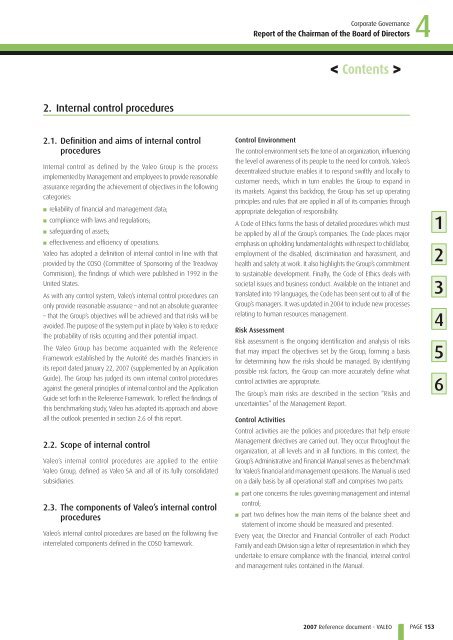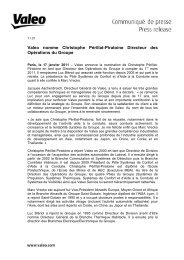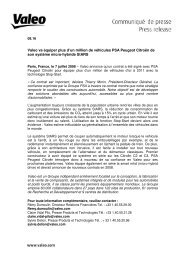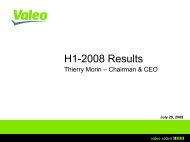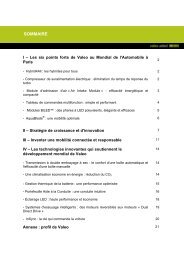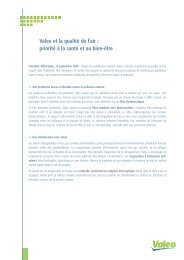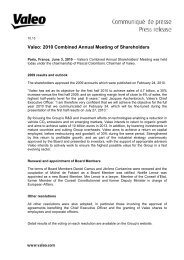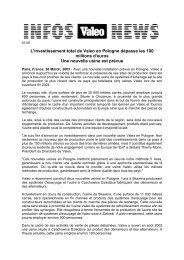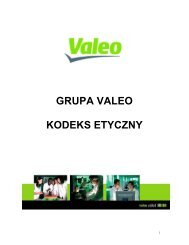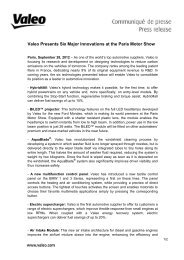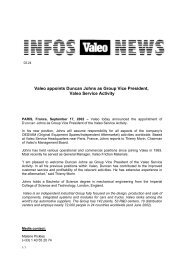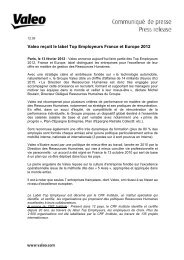2007 Reference document (PDF) - Valeo
2007 Reference document (PDF) - Valeo
2007 Reference document (PDF) - Valeo
You also want an ePaper? Increase the reach of your titles
YUMPU automatically turns print PDFs into web optimized ePapers that Google loves.
2. Internal control procedures<br />
2.1. Defi nition and aims of internal control<br />
procedures<br />
Internal control as defined by the <strong>Valeo</strong> Group is the process<br />
implemented by Management and employees to provide reasonable<br />
assurance regarding the achievement of objectives in the following<br />
categories:<br />
■ reliability of financial and management data;<br />
■ compliance with laws and regulations;<br />
■ safeguarding of assets;<br />
■ effectiveness and efficiency of operations.<br />
<strong>Valeo</strong> has adopted a definition of internal control in line with that<br />
provided by the COSO (Committee of Sponsoring of the Treadway<br />
Commision), the findings of which were published in 1992 in the<br />
United States.<br />
As with any control system, <strong>Valeo</strong>’s internal control procedures can<br />
only provide reasonable assurance – and not an absolute guarantee<br />
– that the Group’s objectives will be achieved and that risks will be<br />
avoided. The purpose of the system put in place by <strong>Valeo</strong> is to reduce<br />
the probability of risks occurring and their potential impact.<br />
The <strong>Valeo</strong> Group has become acquainted with the <strong>Reference</strong><br />
Framework established by the Autorité des marchés financiers in<br />
its report dated January 22, <strong>2007</strong> (supplemented by an Application<br />
Guide). The Group has judged its own internal control procedures<br />
against the general principles of internal control and the Application<br />
Guide set forth in the <strong>Reference</strong> Framework. To reflect the findings of<br />
this benchmarking study, <strong>Valeo</strong> has adapted its approach and above<br />
all the outlook presented in section 2.6 of this report.<br />
2.2. Scope of internal control<br />
<strong>Valeo</strong>’s internal control procedures are applied to the entire<br />
<strong>Valeo</strong> Group, defined as <strong>Valeo</strong> SA and all of its fully consolidated<br />
subsidiaries.<br />
2.3. The components of <strong>Valeo</strong>’s internal control<br />
procedures<br />
<strong>Valeo</strong>’s internal control procedures are based on the following five<br />
interrelated components defined in the COSO framework.<br />
Corporate Governance<br />
Report of the Chairman of the Board of Directors<br />
< Contents ><br />
Control Environment<br />
The control environment sets the tone of an organization, influencing<br />
the level of awareness of its people to the need for controls. <strong>Valeo</strong>’s<br />
decentralized structure enables it to respond swiftly and locally to<br />
customer needs, which in turn enables the Group to expand in<br />
its markets. Against this backdrop, the Group has set up operating<br />
principles and rules that are applied in all of its companies through<br />
appropriate delegation of responsibility.<br />
A Code of Ethics forms the basis of detailed procedures which must<br />
be applied by all of the Group’s companies. The Code places major<br />
emphasis on upholding fundamental rights with respect to child labor,<br />
employment of the disabled, discrimination and harassment, and<br />
health and safety at work. It also highlights the Group’s commitment<br />
to sustainable development. F inally, the Code of Ethics deals with<br />
societal issues and business conduct. Available on the Intranet and<br />
translated into 19 languages, the Code has been sent out to all of the<br />
Group’s managers. It was updated in 2004 to include new processes<br />
relating to human resources management.<br />
Risk Assessment<br />
Risk assessment is the ongoing identification and analysis of risks<br />
that may impact the objectives set by the Group, forming a basis<br />
for determining how the risks should be managed. By identifying<br />
possible risk factors, the Group can more accurately define what<br />
control activities are appropriate.<br />
The Group’s main risks are described in the section “Risks and<br />
uncertainties” of the Management Report.<br />
Control Activities<br />
Control activities are the policies and procedures that help ensure<br />
Management directives are carried out. They occur throughout the<br />
organization, at all levels and in all functions. In this context, the<br />
Group’s Administrative and Financial Manual serves as the benchmark<br />
for <strong>Valeo</strong>’s financial and management operations. The Manual is used<br />
on a daily basis by all operational staff and comprises two parts:<br />
■ part one concerns the rules governing management and internal<br />
control;<br />
■ part two defines how the main items of the balance sheet and<br />
statement of income should be measured and presented.<br />
Every year, the Director and Financial Controller of each Product<br />
Family and each Division sign a letter of representation in which they<br />
undertake to ensure compliance with the financial, internal control<br />
and management rules contained in the Manual.<br />
<strong>2007</strong> <strong>Reference</strong> <strong>document</strong> - VALEO<br />
4<br />
PAGE 153<br />
1<br />
2<br />
3<br />
4<br />
5<br />
6


